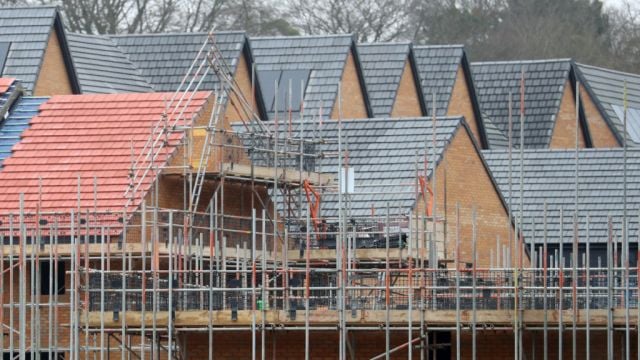An average of 44,000 new housing units are needed every year to keep up with population growth, new research shows.
The Economic and Social Research Institute (ESRI) published a report, funded by the Department of Housing, which estimates the number of housing units needed based on projected population growth at a local authority level.
The research presents a range of scenarios for future structural (demographic) housing demand.
The report considers a range of population projections based on mortality, fertility and various international migration assumptions.
It then estimates future housing demand based on these population projections, as well as a range of assumptions regarding Ireland’s typical household size and the obsolescence rate of the housing stock.
The authors of the report said the total housing demand includes the structural element as well as what is referred to as “pent-up” demand.
Taking the average over all 12 scenarios, structural housing demand is projected to be around 44,000 per year from 2023-2030, and around 40,000 per year over the 2030-2040 period.
This is well above the Government’s housing target to build 33,450 units this year, 36,100 units in 2025 and 36,900 in 2026.
Population projections
In the baseline population scenario, estimated structural housing demand in the period 2023-2030 ranges from around 38,000 to 50,000 per year, depending on assumptions around household size and obsolescence rates.
The Department of Housing will consider the research when revising Ireland’s housing targets.
Minister for Housing Darragh O’Brien said: “The research published today is a valuable contribution to our understanding of future housing demand, the findings of which are based on data from Census 2022 and international trends.
“It does not include latent demand and that is why my department will now take this piece of work, and having regard to analysis already undertaken and the forthcoming update to the National Planning Framework, provide an overall average housing delivery target which will take effect from next year.
“Preliminary estimates put this figure at approximately 50,000 but as committed to, we will publish this and our revised Housing for All targets in the autumn.”
As international migration is the key driver of population growth in the State, additional scenarios are also explored that incorporate higher and lower international migration assumptions than in the baseline scenario.
In a high migration scenario, the estimates range from around 41,000 to 53,000 per year.
In a low migration scenario, the estimates range from 35,000 to 47,000 per year.
In the baseline population scenario, the population is expected to increase by 922,000 between 2022 and 2040, resulting in a total population of more than 6.1 million people by the end of the period.
This implies significant overall population growth of 1 per cent on an annual average basis, according to the report.
In the near term, in the baseline population scenario, the population is expected to increase by 516,000 between 2022 and 2030 or to grow by 1.3 per cent per annum.
In a high international migration scenario, the population grows by an average of 1.2 per cent per year, reaching 6.3 million by 2040.
In contrast, under a low international migration scenario, the population grows by 0.8 per cent per year, resulting in a population of around 5.9 million by 2040.
While population growth is anticipated in all regions, the Eastern and Midland region is expected to see comparatively higher population growth concentrated in Dublin and the Mid-East, while the Northern and Western, and Southern regions are anticipated to see comparatively lower growth.
The research also found that 46.4 per cent of the housing demand over the 2023-2030 period will come from Dublin, across Dublin City, Fingal, Dublin-South and Dún Laoghaire-Rathdown, as well as Cork City and county.
Housing demand for Clare, Donegal, Dún Laoghaire-Rathdown, Galway County, Kerry, Leitrim, Limerick, Louth, Mayo, Roscommon, Sligo, Tipperary, Waterford, Westmeath and Wexford is higher than the population share in those regions, although the differences are small.
Adele Bergin, an author of the report and an associate research professor at the ESRI, said: “Housing demand, both now and in the future, has significant implications for housing policy in terms of the number of housing units required and the areas they are needed.
“Our research shows that, on average, across a range of scenarios, around 44,000 new units a year are necessary to keep up with population growth.”
Paul Egan, another author of the report and a research officer at ESRI, said: “Projections of structural housing demand are sensitive to assumptions including international migration, household size and the obsolescence rate of the housing stock.
“Owing to the uncertainty in any projection exercise, the research considers a range of assumptions.
“It should also be noted that all scenarios relate to future demographic housing demand and do not factor in current pent-up demand.”
Mr O’Brien added: “The targets we have under Housing for All have only ever provided a base of which to work from, they’ve never been a limitation to our ambition as has been proven twice now with overall targets being surpassed in both 2022 and 2023.
“The Government has always been very forthright about capacity constraints and more importantly what we intend to do about them. The largest overhaul of the planning system is proceeding through the Oireachtas at present, a recruitment drive for workers is underway, the draft revised NPF will soon be published and avenues for private finance are being explored.
“Regardless of what our targets are, this Government will continue using every tool available to us to reach and exceed them where possible.”







